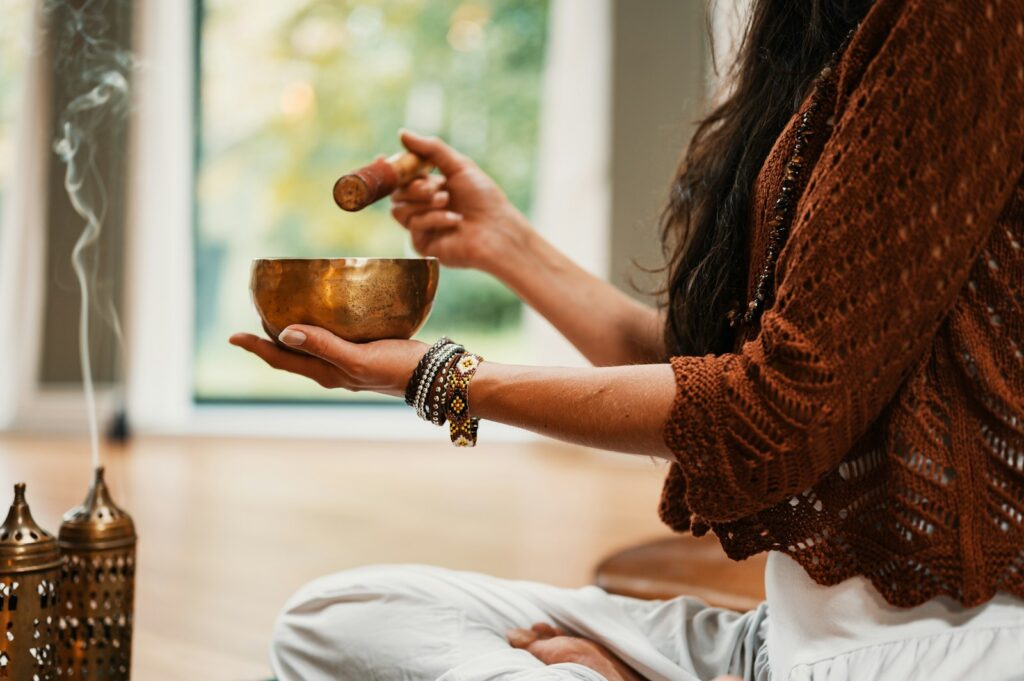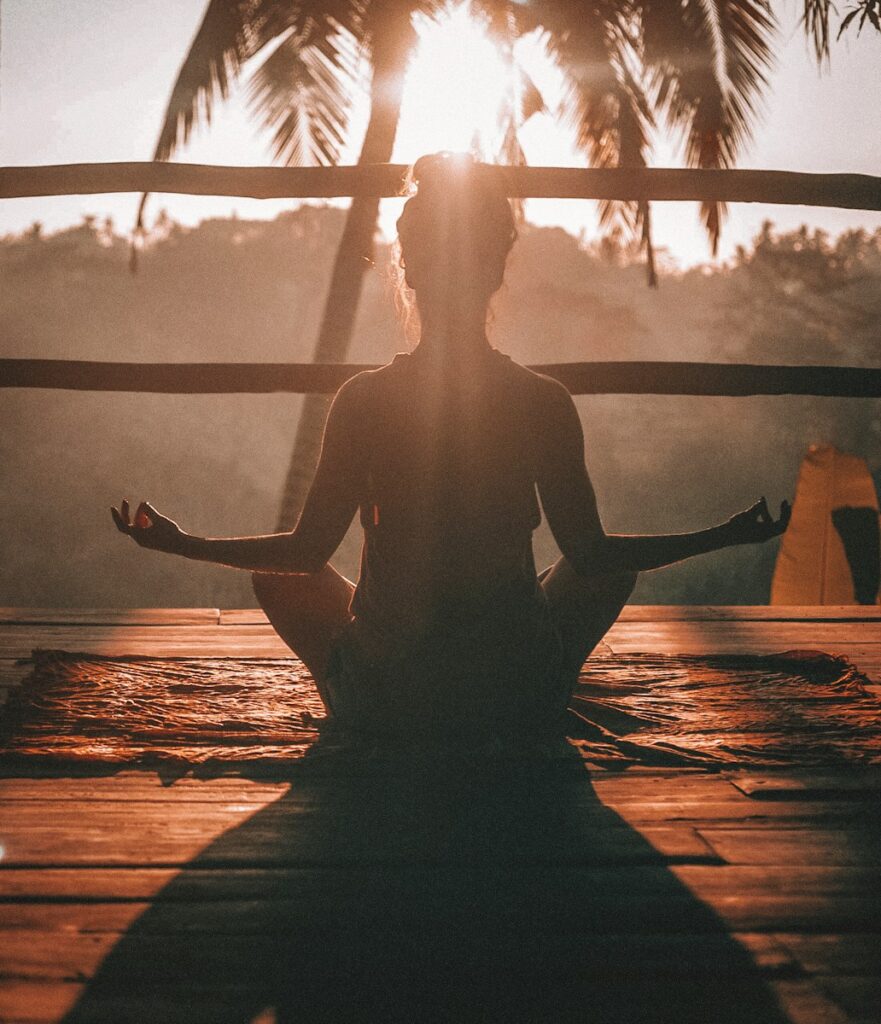Are you feeling overwhelmed or disconnected from the joys of life? Gratitude meditation might just be the key to reclaiming your sense of balance and happiness. By focusing on the positive aspects of life, this practice helps shift your perspective and cultivate a greater appreciation for the present moment.
Even a short, 10-minute gratitude meditation session can bring substantial benefits, such as improved mood and enhanced resilience.
This blog will guide you through the benefits, techniques, and steps to start your own gratitude meditation practice. From journaling exercises to guided meditations, you’ll discover tools to help you feel grounded, joyful, and connected in your daily life.

Introduction to Gratitude Meditation
Gratitude meditation is a powerful practice that can help individuals cultivate a sense of appreciation and thankfulness for the good things in their lives. By focusing on the present moment and acknowledging the positive aspects of their experiences, individuals can begin to shift their perspective and develop a more optimistic outlook.
This practice can be approached in various ways, including through guided meditations, journaling, or simply taking a few moments each day to reflect on the things they are grateful for.
Ready to Start Therapy?
Your healing journey can begin today. Fill out the form below to connect with a therapist who truly listens and understands.
Regular practice of gratitude meditation has been shown to have numerous benefits. It can significantly enhance well-being by fostering positive emotions and improving emotion regulation.
As you begin to integrate gratitude meditation into your daily routine, you’ll likely notice a greater sense of joy and contentment in your life. Whether you choose to follow guided meditations or create your own gratitude rituals, the key is to remain consistent and open to the positive changes this practice can bring to your life.

What Is Gratitude Meditation?
Gratitude meditation is a simple yet profound mindfulness practice that focuses on cultivating gratitude. It encourages you to reflect on the blessings in your life, large and small—from the warmth of the morning sun to the support of loved ones.
The aim is to shift attention away from negative emotions and foster a deep sense of appreciation for all the things that bring you joy and contentment.
Gratitude meditation encourages individuals to take the time to genuinely feel grateful for both significant and minor aspects of life.
Unlike traditional meditation practices, gratitude meditation doesn’t require years of mindfulness training. It’s accessible to everyone, regardless of experience level. Whether you’re a seasoned meditator or a beginner, this practice allows you to anchor yourself in the positive ones and transform your daily life.

The Benefits of Practicing Gratitude Meditation
Gratitude meditation offers a range of emotional, mental, and even physical benefits. Here are just a few ways it can enhance your overall well-being:
- Boosts Positive Emotions: Regularly focusing on feelings of gratitude can evoke happiness, joy, and contentment. Studies show that gratitude practice can increase overall life satisfaction.
- Reduces Negative Emotions: Gratitude meditation shifts your attention from anxiety, fear, or frustration to a more positive outlook. This shift helps with emotion regulation and reduces stress.
- Enhances Relationships: Focusing on gratitude fosters a deeper connection with others. Feeling grateful for the kindness and support you receive can inspire a greater sense of compassion and loving kindness.
- Improves Physical Health: Gratitude has been linked to better heart rate variability, reduced tension, and even improved sleep. By practicing gratitude, you’re supporting both your mind and body.
By bringing intentional focus to gratitude, this meditation supports a healthier and more fulfilling daily life.
Getting Started with Gratitude Meditation
Stepping into a gratitude meditation doesn’t have to be complicated. Follow these simple steps to get started:
- Find Your Space: Choose a quiet, comfortable spot where you feel relaxed. This could be your bedroom, a park, or a cozy chair by the window with a view of nature.
- Focus on Your Breath: Close your eyes and take a few deep, mindful breaths. Notice the sensation of air moving through your nose and into your lungs. With each breath, allow tension to melt away.
- Recall Positive Moments: Bring to mind moments, people, or things you’re grateful for. It could be as simple as the sound of laughter, the support of a friend, or the fact that your body allows you to move freely.
- Feel the Warmth of Gratitude: As you reflect, notice how gratitude feels in your body. Maybe it’s a sense of warmth in your chest, a smile forming on your face, or a sense of relaxation spreading through your shoulders.

Guided Gratitude Meditation Techniques
If you’re new to gratitude meditation or want to deepen your practice, try these specific techniques:
1. Gratitude Journaling Meditation
At the end of your day, set aside 10 minutes to write down three things you’re thankful for. Be specific. For example, instead of writing “I’m grateful for my job,” write “I’m grateful for my supportive coworkers who made me smile today.” This exercise improves awareness and helps you notice positive moments more often.
2. Loving-Kindness Meditation
Combine gratitude with loving kindness by focusing on sending positive emotions to yourself and others. Start by silently offering phrases like, “May I be happy. May I be healthy.” Then extend these feelings toward loved ones, friends, and even strangers.
3. Sensory Awareness Meditation
Use your senses to notice and appreciate the world around you. Focus on the details of the moment, like the aroma of your morning coffee, the texture of a cozy blanket, or the beauty of sunlight filtering through the leaves.
4. Body Scan Gratitude Meditation
This practice involves focusing on different parts of your body and appreciating their functionality. For example, as you move your awareness to your legs, you can think, “Thank you for supporting me through busy days.” This meditation nurtures both mindfulness and gratitude for your physical being.
Mindfulness and the Power of the Present Moment
Gratitude meditation is deeply intertwined with mindfulness. By staying in the present moment, you can truly appreciate all that life has to offer as it’s happening. Instead of dwelling on past regrets or future anxieties, mindfulness anchors you in the here and now.
Engage your senses and tune in to the present. Notice the way your breath feels, the expression on a loved one’s face, or the sound of birds outside. This awareness allows you to cultivate gratitude for moments that might otherwise slip by unnoticed.

Tips for Establishing a Daily Practice
Building a daily gratitude meditation practice might feel challenging at first, but with consistency and determination, it can become a rewarding habit. Here are some tips to help you stay on track:
- Start with just 10 minutes a day to make it manageable.
- Use guided meditation recordings or apps to provide structure.
- Find opportunities to incorporate gratitude into existing routines, like your morning coffee ritual or evening wind-down.
- Stay patient with yourself. If your mind wanders, gently refocus on your breath or the things you’re thankful for.
Overcoming Challenges and Maintaining Motivation
One of the biggest challenges to maintaining a gratitude practice is overcoming negative emotions and staying motivated. It’s easy to get caught up in negative thoughts and feelings, especially when faced with difficult circumstances.
However, incorporating loving-kindness meditation into your practice can help cultivate a sense of compassion and understanding for yourself and others. This approach can counteract negative emotions and help you stay motivated.
Setting aside a specific time each day to practice gratitude meditation, such as first thing in the morning or before bed, can help establish a consistent routine.
By making gratitude meditation a priority and incorporating it into your daily life, you can experience the many benefits it has to offer. Remember, the goal is to create a habit that feels natural and rewarding, allowing you to fully embrace the positive impact of gratitude on your overall well-being.

Measuring the Impact of Gratitude Meditation
Curious about whether gratitude meditation is making a difference? Take note of changes in your emotional state, relationships, and physical well-being over time. Studies show that consistent gratitude practice can improve mood, reduce anxiety, and even promote better sleep quality.
Even small shifts, like noticing that you smile more often or feel less stressed at work, can be powerful indicators of progress.

Bring Gratitude Into Your Daily Life
Gratitude meditation is more than a practice; it’s a life-changing tool to help you experience joy, improve relationships, and foster well-being. Remember, even small moments of gratitude can have profound effects.
If you’re ready to deepen your gratitude practice, consider exploring guided meditations tailored to your needs. Dr. Matthew G. Mandelbaum offers consultations to help refine your emotion regulation skills and find relaxation through mindfulness techniques. Book a session today!
And don’t forget to share this post with friends or family who might benefit from cultivating gratitude. Together, we can build a more compassionate and joyful world, one moment at a time.
Resources for Meditation
If you’re looking to expand your meditation practice, here are some trusted resources to guide you on your journey:
- Headspace: A widely popular app offering guided meditations, mindfulness exercises, and tools for stress relief and better sleep.
- Calm: This platform provides meditation sessions, breathing exercises, and sleep stories designed to help you find peace and relaxation.
- Insight Timer: A free app with thousands of guided meditations and courses led by renowned teachers, covering a variety of mindfulness practices.
- The Chopra Center: Learn about meditation techniques and practices rooted in Deepak Chopra’s teachings, perfect for enhancing your wellbeing.
- Mindful: An online resource offering articles, guided meditations, and tips to integrate mindfulness into your everyday life.
- 10% Happier: Designed for meditation skeptics, this resource provides straightforward techniques, expert guidance, and courses to make mindfulness more approachable.
- Smiling Mind: Geared towards children and adults alike, this app provides mindfulness programs that are tailored for schools, workplaces, and personal use to support emotional health.
These resources are excellent starting points for newcomers and advanced practitioners alike. Explore them to develop a meditation habit that suits your lifestyle.


